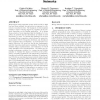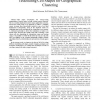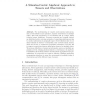914 search results - page 120 / 183 » Detecting Misused Keys in Wireless Sensor Networks |
SENSYS
2003
ACM
14 years 1 months ago
2003
ACM
Event-driven sensor networks operate under an idle or light load and then suddenly become active in response to a detected or monitored event. The transport of event impulses is l...
IEEECIT
2010
IEEE
13 years 6 months ago
2010
IEEE
This paper investigates the energy-saving organization of sensor nodes in large wireless sensor networks. Due to a random deployment used in many application scenarios, much more n...
REALWSN
2010
13 years 2 months ago
2010
Abstract. Environmental scientists frequently engage in "campaignstyle" deployments, where they visit a location for a relatively short period of time (several weeks to m...
GSN
2009
Springer
14 years 11 days ago
2009
Springer
The understanding of complex environmental phenomena, such as deforestation and epidemics, requires observations at multiple scales. This scale dependency is not handled well by to...
SENSYS
2006
ACM
14 years 1 months ago
2006
ACM
It is vital to support concurrent applications sharing a wireless sensor network in order to reduce the deployment and administrative costs, thus increasing the usability and efï¬...



